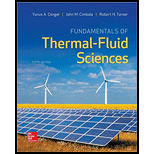
a)
The rate of heat removal from the chicken.
a)
Explanation of Solution
Given:
The average mass of the chicken
The number of chickens dropped into the chiller
The initial temperature of the chicken
The final temperature of the chicken
The specific heat of chicken
Calculation:
Refer TableA-3, “Properties of common liquids, solids, and foods”, select the specific heat at constant pressure
Calculate the mass flow of the chicken.
Write the expression for the energy balance equation for closed system.
Here, rate of net energy transfer in to the control volume is
For the steady flow system, rate of change in internal energy of the system is zero.
Substitute
Here, mass flow rate is
Refer Equation (II),
Calculate the rate of heat removal from the chicken.
Thus, the rate of heat removal from the chicken is
b)
The rate of entropy generation during the process.
b)
Explanation of Solution
Calculate the total rate of heat gained by the water
Calculate mass flow rate of water
Write the expression for the entropy balance in the heat exchanger.
Here, rate of net input entropy is
Substitute
Thus, the rate of entropy generation during the process is
Want to see more full solutions like this?
Chapter 8 Solutions
Fundamentals of Thermal-Fluid Sciences
 Elements Of ElectromagneticsMechanical EngineeringISBN:9780190698614Author:Sadiku, Matthew N. O.Publisher:Oxford University Press
Elements Of ElectromagneticsMechanical EngineeringISBN:9780190698614Author:Sadiku, Matthew N. O.Publisher:Oxford University Press Mechanics of Materials (10th Edition)Mechanical EngineeringISBN:9780134319650Author:Russell C. HibbelerPublisher:PEARSON
Mechanics of Materials (10th Edition)Mechanical EngineeringISBN:9780134319650Author:Russell C. HibbelerPublisher:PEARSON Thermodynamics: An Engineering ApproachMechanical EngineeringISBN:9781259822674Author:Yunus A. Cengel Dr., Michael A. BolesPublisher:McGraw-Hill Education
Thermodynamics: An Engineering ApproachMechanical EngineeringISBN:9781259822674Author:Yunus A. Cengel Dr., Michael A. BolesPublisher:McGraw-Hill Education Control Systems EngineeringMechanical EngineeringISBN:9781118170519Author:Norman S. NisePublisher:WILEY
Control Systems EngineeringMechanical EngineeringISBN:9781118170519Author:Norman S. NisePublisher:WILEY Mechanics of Materials (MindTap Course List)Mechanical EngineeringISBN:9781337093347Author:Barry J. Goodno, James M. GerePublisher:Cengage Learning
Mechanics of Materials (MindTap Course List)Mechanical EngineeringISBN:9781337093347Author:Barry J. Goodno, James M. GerePublisher:Cengage Learning Engineering Mechanics: StaticsMechanical EngineeringISBN:9781118807330Author:James L. Meriam, L. G. Kraige, J. N. BoltonPublisher:WILEY
Engineering Mechanics: StaticsMechanical EngineeringISBN:9781118807330Author:James L. Meriam, L. G. Kraige, J. N. BoltonPublisher:WILEY





